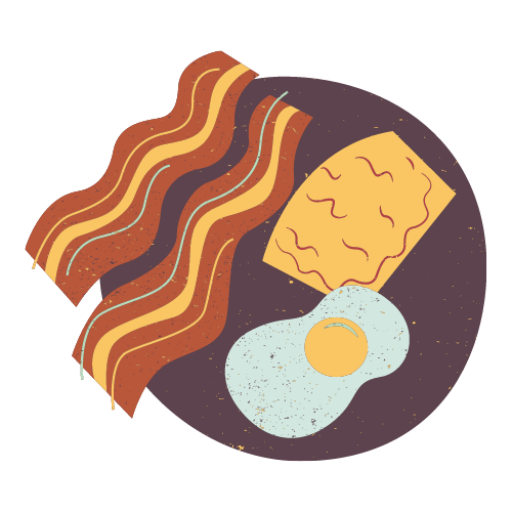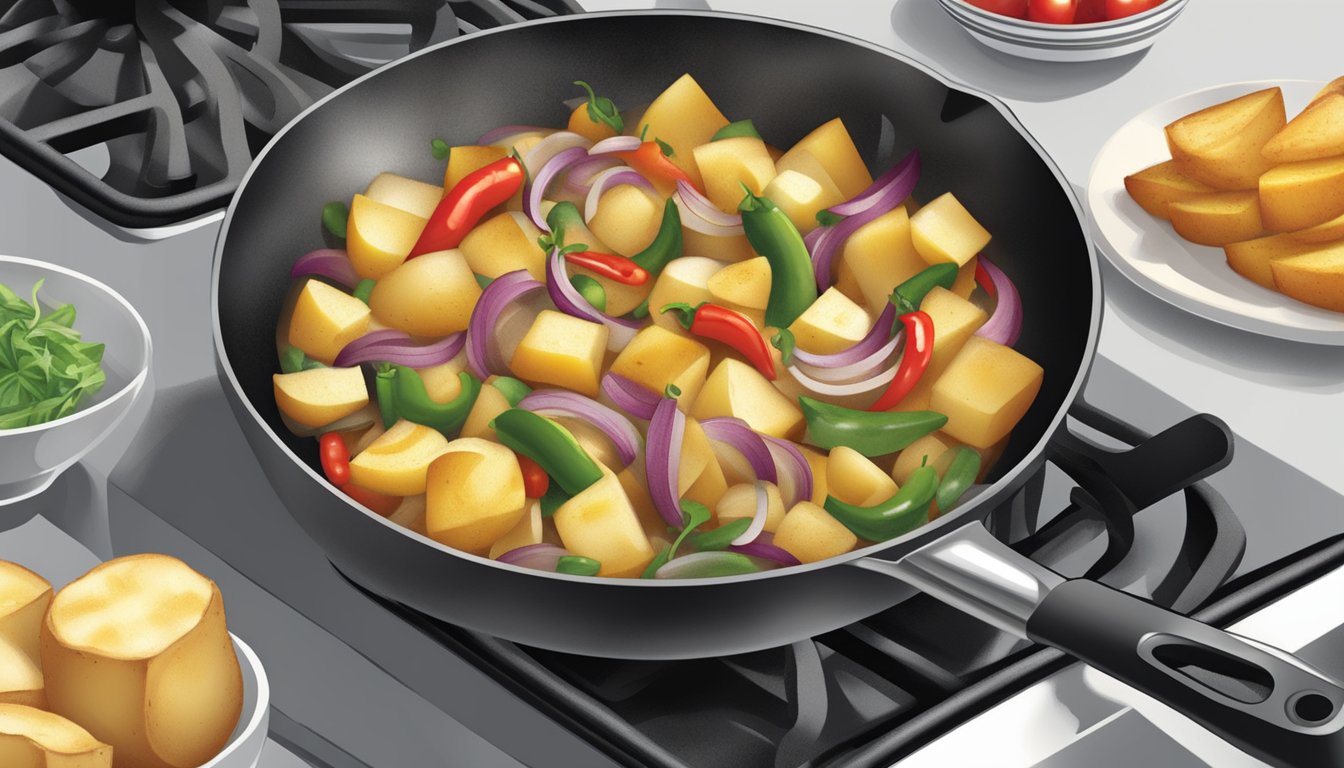Breakfast potatoes are a beloved morning staple that can elevate any meal. These crispy, savory spuds provide a hearty foundation to start the day. To make perfect breakfast potatoes, dice them uniformly, season generously, and roast at high heat for optimal crispiness.
Creating homemade breakfast potatoes is simpler than many realize. The key lies in proper preparation and cooking techniques. By selecting the right potato variety, seasoning thoughtfully, and employing the correct cooking method, anyone can achieve restaurant-quality results in their own kitchen.
Whether baked in the oven or fried in a skillet, breakfast potatoes offer versatility in preparation. They pair well with eggs, bacon, or as a standalone dish. With a few basic ingredients and some simple steps, this classic breakfast recipe can become a regular feature on morning menus everywhere.
Choosing the Right Potatoes

Selecting the ideal potato variety is crucial for creating delicious breakfast potatoes. Different types offer unique textures and flavors that can enhance your morning meal.
Red Potatoes
Red potatoes are a popular choice for breakfast dishes. They have a waxy texture and hold their shape well during cooking. This makes them perfect for crispy home fries or skillet potatoes.
These potatoes have a thin, edible skin that adds color and nutrition to your dish. Their firm texture allows them to be cut into small cubes or slices without falling apart.
Red potatoes have a slightly sweet flavor that pairs well with herbs and spices. They’re also lower in starch compared to other varieties, which helps them maintain their structure when pan-fried or roasted.
Yukon Gold Potatoes
Yukon Gold potatoes offer a balanced combination of waxy and starchy properties. Their golden flesh has a buttery flavor that enhances breakfast dishes.
These potatoes have a creamy texture when cooked, making them ideal for hash browns or potato pancakes. They crisp up nicely on the outside while remaining tender on the inside.
Yukon Golds are versatile and can be used in various breakfast potato recipes. Their natural flavor complements both savory and sweet additions, such as onions, peppers, or even apples.
Russet Potatoes
Russet potatoes are high in starch and have a fluffy texture when cooked. They’re an excellent choice for crispy hash browns or potato wedges.
The high starch content allows russets to develop a crispy exterior when fried or baked. This makes them perfect for achieving that golden-brown crust on breakfast potatoes.
These potatoes absorb flavors well, making them ideal for seasoned breakfast dishes. However, their soft texture means they may break down more easily during cooking, so handle them gently.
Russets are also great for making potato pancakes or latkes due to their ability to bind well when grated and mixed with other ingredients.
Preparation Basics
Proper preparation is key to achieving delicious breakfast potatoes. The following steps cover essential techniques for cleaning, seasoning, and pre-cooking to ensure the best results.
Cleaning and Cutting
Start by thoroughly washing the potatoes under cool running water. Scrub off any dirt or debris using a vegetable brush. Pat them dry with a clean kitchen towel. For even cooking, cut the potatoes into uniform pieces, about 1/2 to 3/4 inch in size. A dice or small cube shape works well for breakfast potatoes.
Choose waxy varieties like Yukon Gold or red potatoes for a creamy interior. Russet potatoes can also be used for a fluffier texture. Leave the skin on for added nutrition and texture, or peel if preferred.
Seasoning Mix
Create a flavorful seasoning blend to elevate your breakfast potatoes. Combine 1 teaspoon each of salt, black pepper, garlic powder, and onion powder in a small bowl. Add 1/2 teaspoon of paprika for color and mild sweetness.
Adjust the ratios to suit your taste preferences. For a smoky flavor, include a pinch of smoked paprika. Sea salt can be used instead of table salt for a more nuanced taste.
Sprinkle the seasoning mix over the cut potatoes, ensuring even distribution. Toss gently to coat all pieces thoroughly.
Pre-cooking Techniques
Parboiling is an effective pre-cooking method for breakfast potatoes. Place the cut potatoes in a pot of cold, salted water. Bring to a boil and cook for 3-5 minutes until slightly tender but still firm.
Drain the potatoes in a colander and let them steam dry for a few minutes. This step helps create a crispy exterior when cooking.
For extra crispiness, rough up the edges of the parboiled potatoes by shaking them in the colander. This creates more surface area for browning.
Alternatively, microwave the cut potatoes for 4-5 minutes, stirring halfway through. This method is quicker but may result in less crispy potatoes.
Cooking Methods
Breakfast potatoes can be prepared using various techniques to achieve different textures and flavors. The choice of cooking method affects the final result, from crispy exteriors to tender interiors.
Skillet Breakfast Potatoes
Skillet breakfast potatoes, also known as home fries, offer a crispy texture and rich flavor. Start by dicing potatoes into small, uniform cubes. Heat olive oil in a skillet over medium-high heat. Add the potatoes and cook for 10-12 minutes, stirring occasionally.
Season with salt, pepper, and desired spices like paprika or garlic powder. For extra crispiness, press the potatoes against the skillet and let them cook undisturbed for 2-3 minutes. Flip and repeat. The result is golden-brown, crispy potatoes perfect for any breakfast plate.
Baked Breakfast Potatoes
Baked breakfast potatoes provide a healthier alternative with less oil. Preheat the oven to 425°F (218°C). Cut potatoes into wedges or cubes. Toss with olive oil, salt, pepper, and herbs like rosemary or thyme.
Spread potatoes on a baking sheet in a single layer. Roast for 25-30 minutes, flipping halfway through. The potatoes are done when golden brown and easily pierced with a fork. This method yields crispy exteriors and fluffy interiors.
Different Potato Forms
Breakfast potatoes come in various forms, each with unique characteristics. Hash browns are shredded potatoes formed into patties and fried until crispy. They’re often cooked in a skillet with oil or butter.
Latkes, traditional Jewish potato pancakes, are made by grating potatoes and onions, mixing with eggs and flour, then frying in oil. They offer a crispy exterior with a soft center.
Potato cubes can be boiled briefly before roasting or frying for faster cooking and improved texture. This technique works well for both skillet and oven methods, resulting in crispy outsides and creamy insides.
Flavor Enhancements
Elevating breakfast potatoes with carefully chosen flavor enhancements can transform a simple dish into a memorable culinary experience. The right combination of herbs, spices, and creative additions can awaken taste buds and add depth to this morning staple.
Herbs and Spices
Fresh herbs bring vibrant flavors to breakfast potatoes. Sprinkle chopped parsley over the finished dish for a burst of color and freshness. Rosemary and thyme impart aromatic notes when added during cooking.
Dried spices offer powerful flavor boosts. Smoked paprika lends a subtle smokiness, while cayenne pepper provides a spicy kick. Experiment with chili powder for a Southwestern twist.
Garlic powder and onion powder are classic additions that enhance the savory profile of potatoes. For a more intense garlic flavor, sauté minced fresh garlic before adding the potatoes.
Creative Flavor Additions
Think beyond traditional seasonings to create unique flavor profiles. Grated Parmesan cheese melted over hot potatoes adds a salty, umami element.
Drizzle truffle oil for an indulgent touch, or toss potatoes with pesto for an Italian-inspired breakfast. Crumbled bacon bits introduce a smoky, meaty flavor.
For a tangy twist, mix in whole grain mustard or sprinkle potatoes with za’atar, a Middle Eastern spice blend. Caramelized onions folded into the potatoes provide sweetness and depth.
Experiment with different combinations to find your perfect flavor enhancement. Remember, a little goes a long way – start with small amounts and adjust to taste.
Serving Suggestions
Breakfast potatoes are versatile and pair well with numerous dishes. Their crispy exterior and fluffy interior complement a variety of flavors and textures.
As a Side Dish
Breakfast potatoes shine as a side dish for classic morning fare. Serve them alongside crispy bacon or sausage links for a hearty start to the day. They also pair wonderfully with eggs prepared in various styles – fried, scrambled, or poached.
For a lighter option, serve the potatoes with grilled tomatoes and sautéed spinach. This combination creates a balanced and nutritious meal. Avocado toast is another excellent pairing, with the creamy avocado contrasting nicely against the crispy potatoes.
Incorporating into Breakfast Dishes
Breakfast potatoes can be integrated into many popular morning dishes. Add them to breakfast burritos for extra texture and flavor. The potatoes provide a satisfying element alongside eggs, cheese, and other fillings.
Use the potatoes as a base for breakfast tacos. Top them with scrambled eggs, salsa, and cheese for a delicious twist on the traditional breakfast. They can also be added to egg muffins or frittatas for a more substantial meal.
For a sweet and savory combination, serve the potatoes with French toast. The contrast between the crispy, savory potatoes and the sweet, syrupy toast creates an interesting flavor profile.
Storing and Reheating
Proper storage and reheating techniques are crucial for maintaining the quality and safety of leftover breakfast potatoes. Following the right methods ensures your potatoes retain their flavor and texture when served again.
Proper Storage
Store leftover breakfast potatoes in an airtight container in the refrigerator. They will remain fresh for up to 3-4 days. For longer storage, freeze the potatoes in a freezer-safe bag or container. Remove as much air as possible to prevent freezer burn. Label the container with the date to track freshness.
Avoid storing potatoes at room temperature for extended periods, as this can promote bacterial growth. If you’ve prepared a large batch, divide it into smaller portions before refrigerating or freezing. This allows for quicker cooling and easier reheating of individual servings.
Reheating for Best Quality
To reheat refrigerated breakfast potatoes, preheat your oven to 400°F (200°C). Spread the potatoes in a single layer on a baking sheet. Drizzle with a small amount of oil to help restore crispness. Heat for 10-15 minutes, turning once halfway through.
For frozen potatoes, thaw them in the refrigerator overnight before reheating. Use the oven method described above, increasing the heating time to 15-20 minutes.
Alternatively, reheat potatoes in a skillet over medium heat. Add a bit of oil and stir occasionally until hot and crispy. This method works well for smaller portions.
Avoid using the microwave, as it can make the potatoes soggy. If pressed for time, microwave for 1-2 minutes, then finish in a hot skillet for crispness.
Nutritional Information

Breakfast potatoes provide a mix of essential nutrients and calories to start your day. The specific nutritional profile can vary based on preparation methods and added ingredients.
Caloric Content
A typical serving of breakfast potatoes contains around 170-180 calories. This calorie count may increase with added fats or oils used in cooking. Fried breakfast potatoes tend to be higher in calories compared to those that are baked or air-fried.
Portion size plays a crucial role in calorie intake. A 4-ounce serving is common, but restaurant portions may be larger. Cooking methods significantly impact calorie content. Air frying can reduce calories while maintaining a crispy texture.
Macronutrients and Micronutrients
Breakfast potatoes provide a balance of macronutrients. They typically contain:
- Carbohydrates: 45-50% of total calories
- Fat: 40-47% of total calories
- Protein: 7-10% of total calories
A serving offers about 25g of carbohydrates, 7g of fat, and 3-13g of protein. The fat content varies based on cooking methods and added oils.
Potatoes are rich in micronutrients. They provide:
- Vitamin C: Up to 74% of daily value
- Potassium: 63% of daily value
- Iron: 97% of daily value
- Fiber: 13g or 54% of daily value
Sodium content can be high, reaching 635mg per serving. This amount may increase with added salt or seasonings.
Variations and Related Dishes

Breakfast potatoes offer endless possibilities for customization and culinary creativity. From international flavors to innovative twists on classics, there are numerous ways to elevate this morning staple.
International Breakfast Potatoes
Breakfast potatoes take on unique flavors around the world. In Spain, patatas bravas feature crispy cubed potatoes served with a spicy tomato sauce. German kartoffelpuffer are savory potato pancakes often enjoyed with applesauce or sour cream.
Irish boxty combines grated and mashed potatoes into a hearty pancake, while Indian aloo paratha stuffs spiced potatoes into flatbread. These international variations showcase how potatoes adapt to different culinary traditions.
For a Mexican-inspired breakfast, try crispy potatoes seasoned with chili powder, cumin, and garlic, served alongside eggs and salsa.
Creative Twists on Classics
Classic breakfast potatoes can be reinvented with creative ingredients and cooking methods. Waffle iron hash browns offer a crispy exterior and fluffy interior. Spiralized potato nests make an eye-catching base for poached eggs.
For a healthier option, sweet potato hash combines diced sweet potatoes with bell peppers and onions. Roasted breakfast potatoes tossed with herbs like rosemary and thyme provide a flavorful alternative to traditional hash browns.
Try adding unexpected ingredients like diced apples or crumbled bacon to your crispy breakfast potatoes for a unique flavor profile.
Breakfast Potato Casserole
Breakfast potato casseroles offer a convenient make-ahead option for feeding a crowd. Tater tot breakfast casserole layers crispy potato bites with eggs, cheese, and breakfast meats for a hearty morning meal.
A hash brown casserole combines shredded potatoes with a creamy sauce, cheese, and often diced onions or peppers. For a lighter version, use Greek yogurt instead of cream soup.
Experiment with different cheeses, vegetables, or proteins to create your own signature breakfast potato casserole. These versatile dishes can be prepared the night before and baked in the morning for a stress-free breakfast.




